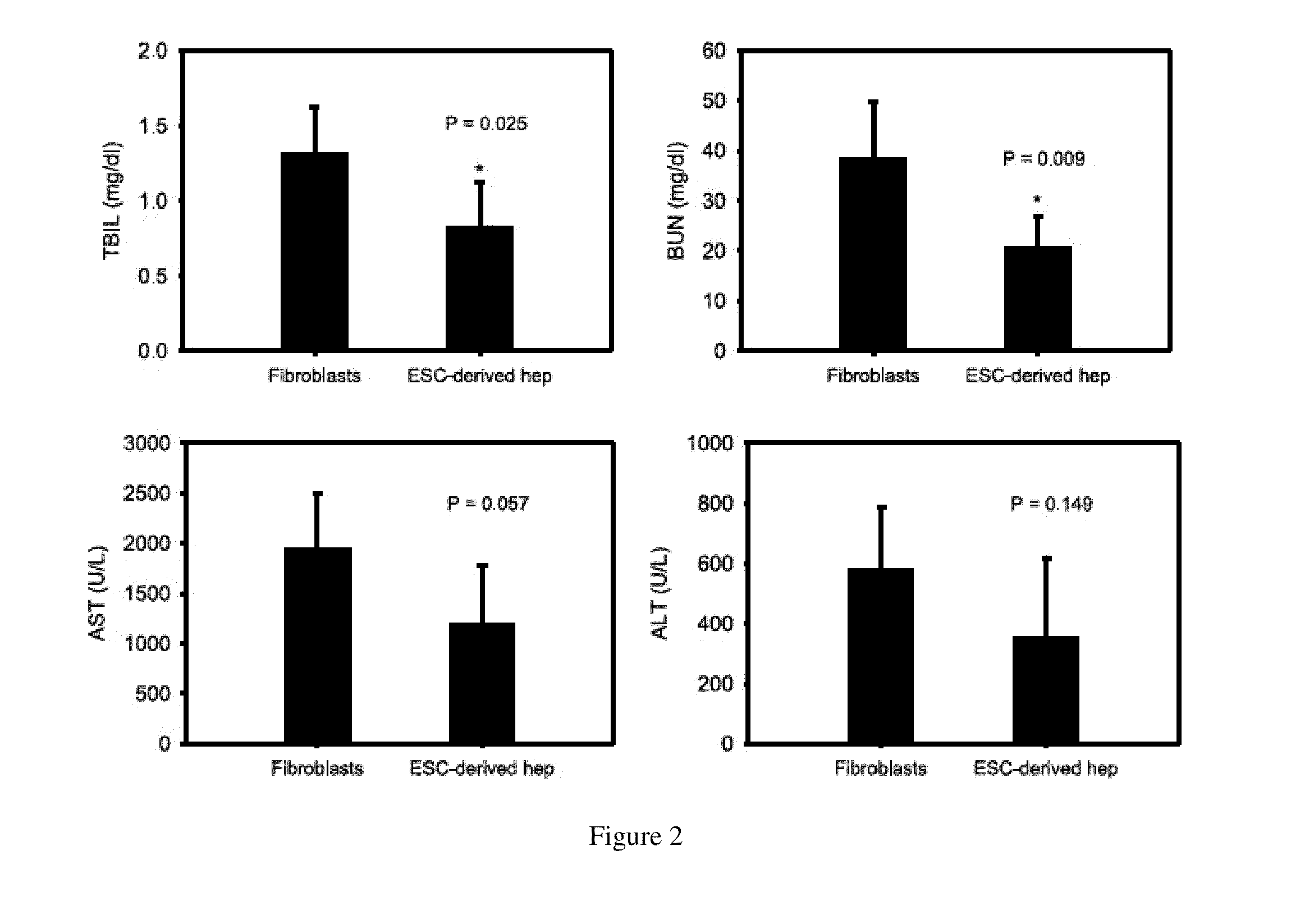Homogeneous differentiation of hepatocyte-like cells from embryonic stem cells
- Summary
- Abstract
- Description
- Claims
- Application Information
AI Technical Summary
Benefits of technology
Problems solved by technology
Method used
Image
Examples
example 2
Isolation and Culture of ES-Derived Cells
[0065]To separate the ES-derived cells from the hepatocytes in coculture, the cells were treated on day ten with 1 mg / mL dispase (Life Technologies, Inc.) for 60 min at 37° C. After the dispase treatment, the ES cell-derived cells could be detached by gentle pipetting without disturbing the collagen gel. The collagen-sandwiched hepatocytes remained at the bottom of the dish, thus allowing separation of the ES-derived cells from the primary hepatocytes. The ES-derived cells were then treated with trypsin to achieve single-cell suspension. The purified ES-derived cells were either analyzed for gene and protein expression or were replated in 35-mm culture dishes at a density of 50,000 cells per dish (6.25×103 ES cells / cm2). For further differentiation, isolated ES-derived cells were plated either on collagen gels or growth-arrested 3T3-J2 fibroblast feeder layers and were cultured in hepatocyte culture medium supplemented with 100 ng / mL oncostat...
example 3
Differentiation of ES-Derived Cells
[0066]To isolate the ES-derived cells in co-culture, the ES cells cultured on top of collagen sandwiched hepatocytes were incubated with dispase (1 mg / mL) (Gibco) for 30-60 min at 37° C. After incubation, the ES-derived cells were detached by gentle pipetting. The collagen-sandwiched hepatocytes remained at the bottom of the dish, thus allowing separation of the ES-derived cells from the primary hepatocytes. The isolated ES-derived cells were replated (day 10) on collagen gel coated 35-mm dishes at a density of 400,000 ES-derived cells per dish and cultured in high glucose DMEM supplemented with 10% FBS, 100 ng / mL oncostatin-M (Sigma), 0.2 μM dexamethasone (Sigma), and insulin / transferrin / selenious acid (5 μg / mL, 5 μg / mL, 5 ng / mL, respectively) (BD Biosciences, San Jose, Calif.). The replated cells were allowed to recover for four days before induction of hepatocyte differentiation.
[0067]At day fourteen of culture, the ES cells were stimulated with...
example 4
Experimental Animals
[0068]Male Sprague-Dawley rats (Charles River Laboratories, Boston, Mass., USA), weighing from 250 g-350 g, were used for this study. All animals were acclimated to the animal research laboratory for 5 days prior to experiments and were maintained in a light-controlled room (12-h light-dark cycle) at an ambient temperature of 25° C. with chow diet and water ad libitum. These rats were maintained in accordance with National Research Council guidelines, and the experimental protocols were approved by the Subcommittee on Animal Care, Committee on Research, MA General Hospital.
PUM
 Login to View More
Login to View More Abstract
Description
Claims
Application Information
 Login to View More
Login to View More - R&D
- Intellectual Property
- Life Sciences
- Materials
- Tech Scout
- Unparalleled Data Quality
- Higher Quality Content
- 60% Fewer Hallucinations
Browse by: Latest US Patents, China's latest patents, Technical Efficacy Thesaurus, Application Domain, Technology Topic, Popular Technical Reports.
© 2025 PatSnap. All rights reserved.Legal|Privacy policy|Modern Slavery Act Transparency Statement|Sitemap|About US| Contact US: help@patsnap.com



